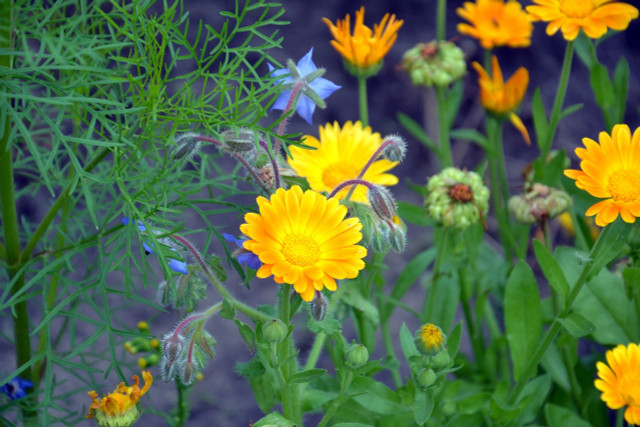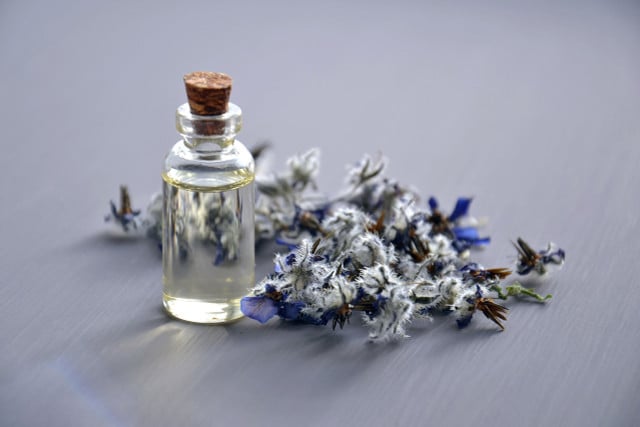
Borage is very appreciated by herb lovers, but is still quite unknown. Yet you can easily collect the herb and grow it yourself. Borage is also versatile in the kitchen.
Borage is an annual herbaceous plant and belongs to the family of broadleaf plants. Depending on conditions, the plant reaches a height of 50 to 90 centimeters. Since borage has a taste reminiscent of cucumbers, the plant is also called cucumber herb.
Originally, borage comes from the Mediterranean region. In the Middle Ages, the herb was brought to Central Europe and cultivated mainly in monastery gardens. Borage was valued as a medicinal plant and used for various ailments. Besides its hairy leaves, you can identify borage by its small purple to bright blue flowers.
Contents
Borage in your garden

Borage is frugal and easy to plant. In addition, the flowers attract bees and bumblebees.
Location:
Since borage is native to the Mediterranean region, the plant prefers a sunny spot sheltered from the wind.
The soil should be calcareous and loose.
Borage is frugal and does not make great demands on the soil, but it should not be too rich in nutrients either.
Sowing:
- Borage is sensitive to frost, so it should not be sown until late April.
- Depending on your needs, you can reseed throughout the summer.
- Borage belongs to the dark germinators. For the seeds to germinate, they should be about two to three inches below the soil.
- The germination time can be up to two weeks.
- You should maintain a distance of 30 to 45 centimeters between rows.
Care:
- Cucumber weed is considered low maintenance. Thus, the plant in the garden usually does not require fertilizer.
- The plants spread a lot and tend to sprawl. To prevent this, simply cut off the seed heads after flowering.
- Borage is sensitive to drought. Therefore, on hot summer days, you should water the plant additionally.
Pests:
Borage is particularly susceptible to aphids. Powdery mildew can also occur occasionally.
However, you can prevent pests by keeping the distance between the plants.
In addition, mixed cultivation with marigolds has proven useful.
Harvest:
- From mid-May you can harvest flowers and leaves continuously.
- The young, soft leaves are best for cooking. The older ones taste hard and woody.
- Tip: You can also plant borage on the balcony in a pot. Since the plant develops large roots, it is important that the pot is large enough. On the balcony, you must take special care that the soil does not dry out.
Borage: ingredients and effect

Borage has a long tradition as a medicinal plant. Thus, the leaves were used for liver cleansing, while the flowers were supposed to reduce fever. However, these effects could not be scientifically proven.
Due to the pyrrolizidine alkaloid content, intensive internal use is discouraged today. The substance is said to cause liver damage with long-term use. The Federal Office for Risk Assessment classifies occasional consumption of borage as harmless.
Borage also contains many ingredients that have a positive effect on the body:
- essential oils
- saponins
- minerals especially calcium
- vitamin C
Today, borage is mainly used for external treatment as a medicinal plant. Mostly pure borage oil is used for this purpose, but the oil can also be found in ointments and creams.
The oil from the seed of the plant contains valuable omega-6 fatty acids and gamma-linolenic acid. These substances are said to relieve itching and have an anti-inflammatory effect. That is why it is mainly used for skin diseases such as neurodermatitis, dandruff or dry skin. However, there is no clear evidence from studies for the effect.
How to use borage in the kitchen

Borage captivates with its unique taste. It is reminiscent of cucumber and has a subtle sour note. In the kitchen you can use the whole plant – leaves, stems and flowers are edible.
It is best to harvest the leaves just before processing them. Borage withers quickly and loses its flavor. To enjoy the full flavor, borage should be eaten mostly raw.
Borage is especially good as a salad, for example with cucumbers or tomatoes. The taste refines herb curd or a simple buttered bread, but borage is also suitable for pickling cucumbers. You can also decorate desserts with the sweet flowers or freeze them in ice cubes and use them for summer lemonades.
You can also prepare borage in a similar way to spinach. You should make sure to steam the leaves only briefly at low temperature. The delicate flavor also harmonizes particularly well with dill.
Unlike many kitchen herbs, borage cannot be dried and loses its flavor. If you still want to preserve the flavor, you can pickle the leaves in oil.

